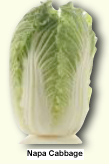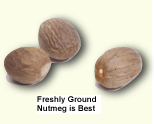 Makes 2 Quarts (Easily Halved)
Makes 2 Quarts (Easily Halved)
SLAWS CAN TAKE ON A VARIETY of cultural twists. They satisfy the need for raw, crunchy sides or sandwich toppers. This pickled version offers a play on kimchi with pinches of spices from Indochina.
For a speedier version, choose pre-bagged Asian slaw mixes (1-1/2 LBS total); find in the produce section. That will replace the cabbage and carrots below.
- Recipe by B. Hettig © 2010
| Chinese cabbage | 1-1/2 LBS (.45 kg) | aka "Napa," shredded |
| scallions | 1 cup | sliced thinly on bias |
| carrots | 1/2 LB (.27 kg) | shredded |
| garlic | 2 TBS | (3 cloves), minced |
| ginger root | 2 TBS | peeled, finely grated |
| Korean Chile Flakes | 2 TBS | or to taste (can adjust anytime) |
| sea salt, unrefined | 2 TBS (scant) | finely ground, not coarse* |
| cracked pepper | 1 tsp | |
| nutmeg | 1/2 tsp | fresh grated is better |
| allspice powder | 1/2 tsp | |
| dry mustard | 2 tsp |
- Shred cabbage and carrots. Slice scallions. Combine in large, tall bowl. Add sea salt. Toss
 with hands, squeezing mixture for a few minutes to help develop a brine.
with hands, squeezing mixture for a few minutes to help develop a brine. - Add in the remaining spice mixtures and toss well.
- Load pickling jar, tamping firmly as you proceed. Add in any remaining brine. Push the mixture beneath the brine.
- Review pages 8-9 in your instruction booklet to complete a slaw style recipe or view our video on making kraut and slaw.
TIPS
* Use fine sea salt when making sauerkraut or slaw. There is more contact with the vegetables and will speed up the brine formation.
 The ever versatile Korean chile flakes (gochugaru) can be found at Asian markets. They are in coarse flake form and are ready to use. (We sell them on our site). I find they work well as a basic chile powder for most recipes. It has a medium spiciness that doesn’t linger on the palate.
The ever versatile Korean chile flakes (gochugaru) can be found at Asian markets. They are in coarse flake form and are ready to use. (We sell them on our site). I find they work well as a basic chile powder for most recipes. It has a medium spiciness that doesn’t linger on the palate.
All chiles evolved from Central and South America. So any chile is ultimately of New World origin. Kimchi and other Old World chile-based dishes really only began in the 16th century. How’s that for “old?”
